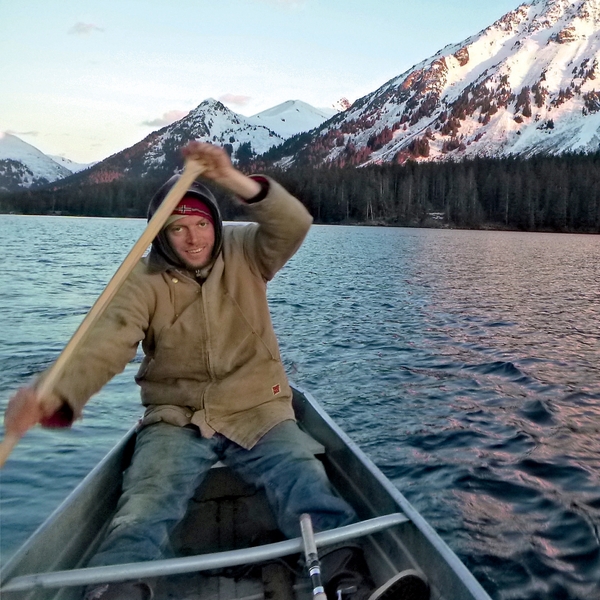The Frenchman Who Followed Chris McCandless Into Alaska
When François Guenot vanished last summer on a wild and remote Alaskan coastline, many in the state dismissed him as yet another unprepared greenhorn. But a revelatory road trip with François's father and brother revealed he was something special: a tough, soulful wanderer whose story resonates with the grand traditions of the American outdoors.
New perk: Easily find new routes and hidden gems, upcoming running events, and more near you. Your weekly Local Running Newsletter has everything you need to lace up! .
On the morning of May 26, 2014, two Alaskan state biologists were in a Cessna floatplane, counting fish from the window as a pilot took them down the Alaska Peninsula, a huge, curved harpoon of land that juts toward Russia from the southeast. Just then they were in an area fronting Kamishak Bay, on the coast north of .��
Seen from above, the peninsula’s landscape looks like a runny soufflé, a cracked and wrinkled pillow of mossy tundra perforated with hundreds of inkblot lakes. In the distance, the biologists could see glaciers twisting off the flanks of Mount Douglas, the 7,021-foot volcano that stands sentry over one of Alaska’s diciest water passages: the maritime pinball machine known as the Shelikof Strait. No roads lead in or out of where they were, and reaching the nearest village requires several days of bushwhacking through grizzly-infested alder thickets.��
Suddenly, one of the men spotted the white cork floats of a fishing net. “Whoa! That’s a gill net,” Glenn Hollowell shouted to his partner, Ted Otis, over the hum of the propeller. The net was stretched across the mouth of Amakdedori Creek, blocking it entirely. They stared in disbelief at such a blatant violation of fisheries regulations, in a place where a major sockeye salmon run was only two weeks away. The sea was remarkably calm, and their pilot offered to land the plane on its pontoons.
When the biologists hopped out onto the beach, they were greeted by a man with a disarming smile and a thick French accent. “I am François!” he said, holding out his hand. François was a spare, muscular guy in his mid-thirties with a sunburned nose, a scraggly beard, and a bandana wrapped around his mostly bald head. His clothes were unwashed and tattered, and he reeked of wood smoke and body odor. He looked like a feral orphan, a postpubescent Little Prince who’d spent too many years stranded in the Sahara.
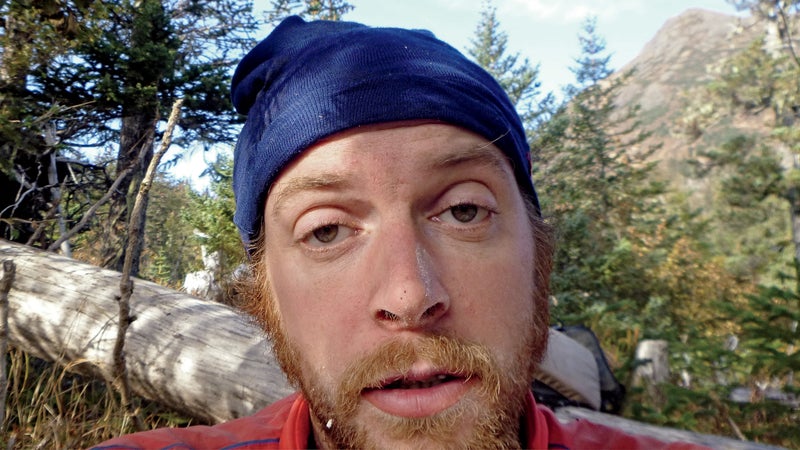
As François led the men to the net, he told them he’d just set it out and had caught only a single starry flounder. “I don’t think he understood it was illegal,” says Otis, who’s been working in the region since the late 1980s. Otis told François that he was obligated to confiscate the net and describe what he’d seen to state wildlife troopers. “Do you have any identification?” he asked.
François clammed up at this but then led the men back to a dilapidated cabin on a grassy bluff above the beach. It was patched together with sun-bleached driftwood and orange, blue, and green fishing nets.
Otis leaned inside the creaky structure and watched François dig through his bags on the floor. He had a surprising amount of stuff in his camp, including a cloth-covered folding kayak that had seen better days. François had scavenged for parts in a dump and mended tears with melted plastic bags and tree sap. The kayak’s open cockpit was expansive enough to fit three people, and he shielded it from sea spray using little more than thin plastic sheeting. The boat’s most impressively crappy feature was its rudder, which François had jury-rigged out of found materials. In lieu of pedals for steering, he wrapped two lines around his feet. He had another line extending from the jib of his sail that he would trim with his body or stick between his teeth. “It was not the type of gear that I would go on an adventure with,” Otis says.
François never produced a passport. Whether he couldn’t find it or didn’t want to—it had been expired for a year by that point—is unclear. After 20 minutes on the ground, Otis and Hollowell were anxious to get back to the plane before the weather turned bad. As they left, Otis pulled out his iPhone and snapped a grainy, backlit picture of the mysterious Frenchman he’d just met.
François’s full name is François Guenot. We know that because his passport and belongings—including his boat—were discovered on June 19, 2014, scattered along a Katmai beach, about 20 miles south of where the biologists had met him. The wood and metal skeleton of his kayak poked through the red fabric skin like a compound fracture. Two drybags lay less than a quarter-mile away, filled with several weeks’ worth of rice and lentils. Days earlier a vicious storm had whipped down the coast, with winds gusting to 60 miles per hour. Whitecaps peeled off dark swells tall enough to swallow a bus. The Coast Guard scoured the ocean for two days but failed to find François, alive or dead. Officials called off the search.
I first learned about François on the website of the Alaska Dispatch News, the state’s largest newspaper. , a man named Gary Nielsen, a small-town general-store owner who'd met François, said he was “dangerously naive” and “could not get it into his mind the distances involved here.”
François's greatest accomplishment was drawing out virtue in the people he met, and he in turn was rewarded by this. “Alaska is a vast, emotional land,” he wrote in his journal. “Relationships center me.”
The comments under this story were hard on François. Many Alaskans saw him as yet another rootless fool on the yahoo spectrum that stretches from Chris McCandless to grizzly man Timothy Treadwell. But as I learned more about François, I began to wonder if the audacity of his wilderness exploits put him in a different category. I came to believe that he was more than just another unprepared lost soul. He was a street performer whose venue happened to be the Alaskan backcountry. He was also resourceful and tough: some of the things he did, and the distances he covered, are mind-boggling. And his journey was obviously meant to inspire people. As he made clear in his writings and conversations, it was a rebuke against capitalist excess and gear junkies who are convinced they need to have the latest gadgets to fully appreciate the wild.
From reading François’s short-lived , studying journals and maps found in his kayak, reviewing a trail of photos and videos he left on borrowed computers, and talking to people who’d met him, I learned that he had somehow covered 3,000 miles on borrowed skis, department-store bikes, and makeshift boats. After starting his travels in Quebec in 2011, his compass pointed more or less in the direction of Russia’s Kamchatka Peninsula, but he was easily led astray. He dipped down into America’s desert Southwest, up through California and east to Yellowstone, north to the Yukon, and southwest into Alaska. At one point, he built a bike trailer out of a rolling trash can, which he dragged behind him loaded with 70 pounds of food and gear.
“He was a bullheaded son of a bitch who would just go for it,” says Colter Barnes, a school principal in the Alaskan town of Kokhanok, where François lived for roughly nine months, starting in 2013. “He challenged you to live differently.”
“François wasn’t so obsessed with his goal that he missed all the stuff around him,” says Bretwood Higman, a well-known explorer and geologist based in Seldovia, another Alaskan town where François washed up. “In fact, that was most of what he did: have an interaction with the places and people he met along the way. That’s the heart of what I respect about him.”
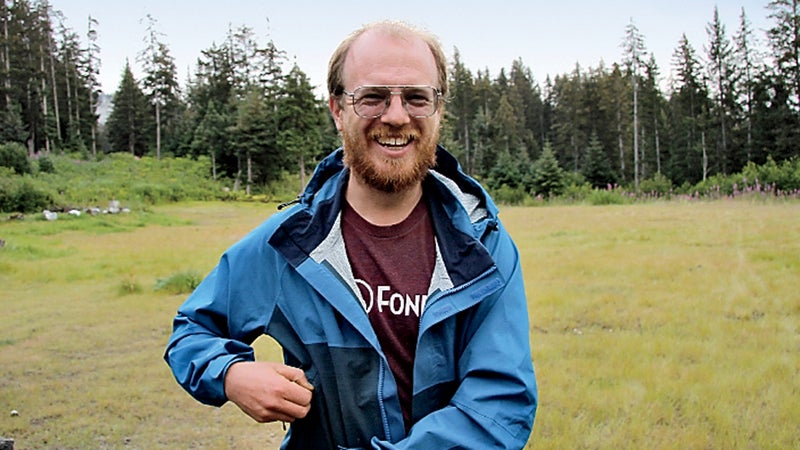
As it happened, François had grown up in the Jura Mountains on the French border with Switzerland, where I’d spent time as a kid. My father took a business course there in 1990, and we lived in the shadow of the Salève, a limestone massif known as the Balcony of Geneva. Switzerland was a major change from my life in suburban Houston; like François, I got my first taste of adventure there, which made him that much more intriguing to me. I also learned to speak passable French.
Searching online one morning last July, I found the website for a business called Moteurs-Loisirs (“Recreational Motors”) in François’s hometown of Maîche. The site features colorful images of chainsaws, snowblowers, and sit-on-top lawn mowers, but the core products are four-wheelers and snowmobiles. “Providers of Pure Feelings!” the slogan went. The shop was owned by a man named Robert Guenot, who I assumed was François’s dad.
I called one day to find out. “Are you François’s father?” I asked in French.
“Le père de François,” he said, as if it were his professional title. He told me that he hadn’t seen his son since he left France almost four years earlier. After the Coast Guard called with news about finding his boat, Robert decided that he would travel to Alaska with François’s younger brother, Philippe. I figured he was just going to collect François’s belongings, but he intended to stay for a month.
“I had already planned to spend my vacation with—” he began. Then his vocal apparatus seized up, and all that emerged was gasping and shuddering. “I had already planned to spend a one-month vacation with François,” he continued. “For me he is still alive. He is going to meet me between the 18th and 20th of July.”
Robert had purchased his ticket months ago. The trip, as originally planned, would be a chance for him to finally understand who his distant son had become. “I will keep you informed if my plan changes,” François had told him in an e-mail. “Big kisses. I love you.”
July 18 was exactly one week away, and I doubted François had survived. He hadn’t been spotted on the coast in nearly two months, and heading inland would have required traversing an ice-covered mountain range and then trekking to Katmai National Park headquarters—a slog that could take over a month. Even so, I wanted to understand what had driven François to take such immense risks. The best way to do that was to join his family in Alaska.
Anchorage was not blessed with an abundance of rental cars when I was there: summer tourists had evidently taken them all. When I arrived to pick up the Guenots in a beat-up minivan the color of a ripe banana, they started laughing. “Does it have brakes?” Robert asked.
“Oui,” Philippe said. “This is a François car.” His brother’s ride back home was such a wreck that you could bring it to a complete stop only by wedging it against a stone wall. “We always wanted to improvise according to whatever we found,” Robert said. “It’s the way François would have liked it.” As we pulled out of the hostel parking lot in our crayon on wheels, white smoke from burning oil curled out of the hood.
Robert, 63, was sporting a Ski-Doo T-shirt and white scruff on his face, thanks to several days without a shave. He was compact, with a reserved, Buddha-like demeanor. Philippe, 32, was decked out in swag from their shop: a Can-Am baseball cap and shell. He is taller, leaner, and more angular than his father, with dark, styled hair and boxy plastic glasses that look vaguely futuristic.
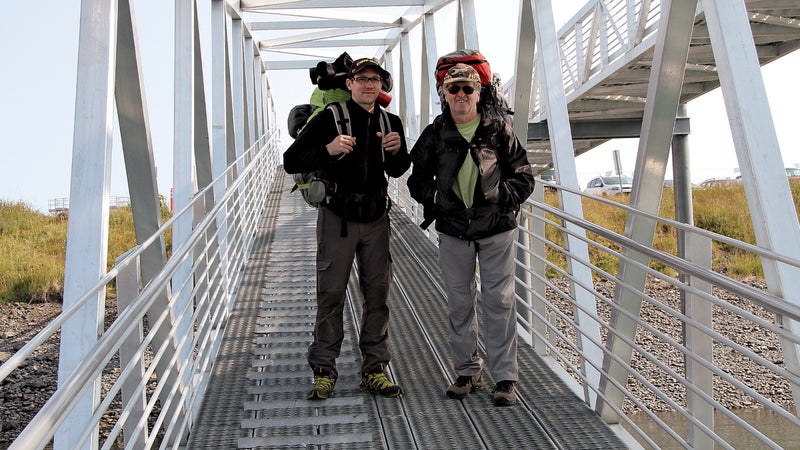
The day before, the Guenots had taken me to their bunk room to dig through two cardboard boxes’ worth of stuff that belonged to François and had been recovered on the beach. “This is what his clothes were like back in Maîche,” Philippe said, holding up a tattered pair of boxer-briefs that looked like a clump of seaweed. We pulled out gloves that were more holes than fabric, a sleeping bag that looked like a patchwork quilt, two ancient GPS units, and a solar panel. The gear was in pitiful shape, but it made François seem more prepared than any of us had expected. He even had two condoms in a ziplock bag.
Robert told me that he’d had his own brush with death in his younger days. In March of 1992, he traveled to Quebec to participate in a three-week snowmobiling expedition to the Hudson Bay, an adventure chronicled in a 2012 book by Romulad Previtali called Amarok Trail: The Wolf Track. In the opening chapter, Robert gets stranded on fracturing ice over the Leaf River as his companions watch helplessly. “It is four o’clock Sunday, March 14,” Previtali writes, “negative twenty-five degrees, Robert motionless, lays on a delicate layer of ice ready, at the slightest movement, to swallow all.”
When I asked Robert again about his goal for this trip, he answered without hesitation: “To tell you the truth, we still hope to find him alive. As long as the Coast Guard has not found his corpse, there is a slim chance.” He and Philippe also wanted to experience the world through François’s eyes, and they saw me as part of that mission. They spoke only a few words of English, and I had already helped them reach out to François’s friends. “The trip is better with you,” Robert said. “We will discover a lot more than if we were alone.”
Our plan was to drive south to Homer and then catch a ferry to Seldovia, which sits on the southern end of the Kenai Peninsula, on the east side of Kachemak Bay. François spent a year there, from the fall of 2012 to the summer of 2013, before crossing the Cook Inlet in his makeshift kayak and, eventually, setting out on his ill-fated exploration of the Alaska Peninsula. After we left Anchorage, we drove along a fjord-like sliver of the inlet, climbed over a low alpine pass, and descended into a moist rainforest. This is the same route François biked with his rolling trash can. Most of the way, we noticed, there was almost no shoulder.
Robert and Philippe studied a map on which François had dutifully marked his campsites. He had covered 30 or 40 miles per day. “People said that François couldn’t comprehend distances in Alaska,” Robert said. “We think that, yes, he knew.”
We stopped at a mile marker where François had taken a selfie; Robert and Philippe hopped out to capture the same shot. “I haven’t felt this close to François in years,” Philippe said.
He credited François with helping him escape from a rut, encouraging him to spend a year in the Dominican Republic in 2009. “The only barrier in our lives is ourselves,” François once told him.
After a five-hour drive, we pitched tents in a meadow, under purplish evening light, and took seats around a fire ring. Across the mirror-flat water of Kachemak Bay, we could make out a saw-toothed mountain range and the white toe of a glacier. Philippe puffed on a cigarette. Robert nervously pawed his phone, looking for news. There wasn’t any.
I told Robert that Gary Nielsen, the skeptical man quoted in the Alaska Dispatch News, had e-mailed me and that he hadn’t given up on François, either. “We don’t think he’s gone,” he wrote. “We think he is walking.”
“That’s nice to know, don’t you think?” Robert said. “That somebody else thinks that?”
When François was six, he jumped off a dining room table and landed on his head. His brain swelled with blood, and doctors shaved off his long blond hair to saw his skull open.
During the two weeks he spent under intensive care, Robert went to see him every day, fearing it could be his last. François recovered and, as he grew up, turned out to be a natural athlete. Robert pushed him to be a competitive cross-country skier. Maybe too hard. By the time François was 15, he had a shelf full of trophies but had grown tired of the sport. One afternoon he came home and threw them all away. “They mean nothing,” he said.
In his late teens, François turned away from the outdoors, drinking and partying with friends for several years. He was 21 and bumbling through college when his parents divorced. He remained close to his mother, Martine, who cared for the elderly, but he saw Robert only sporadically. After he graduated, he had trouble finding work he liked. In 2006, at 28, he hitchhiked to Austria and stayed in a faith-based community for six months.
François didn’t talk about that experience much, but friends and family believe it was transformative, inspiring his craving for simplicity. Later, when François visited Robert in Maîche and helped clean out the yard of a 19th-century stone cottage Robert was restoring, he berated his father with questions about materialism. Why do you work? Why do you buy new clothes? Why do you live in a house? “I like to live my life in a certain manner,” Robert responded curtly. “Nothing was ever small with François,” he says. “I didn’t understand him.”
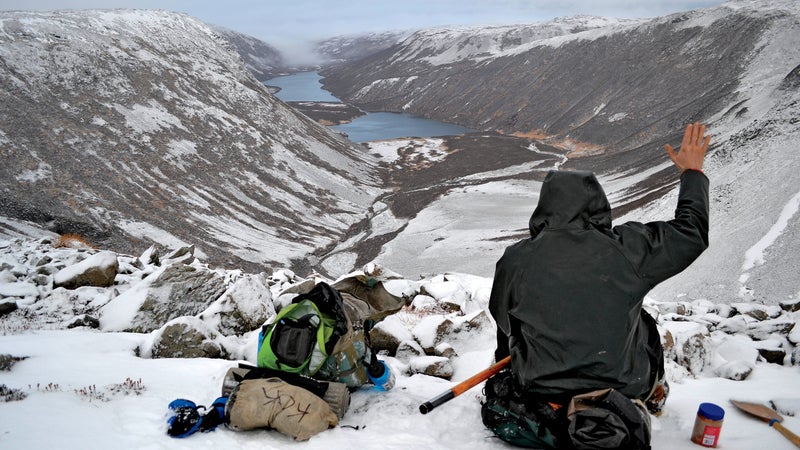
Loic Deforet, a friend of François’s, says that François thought of his father as a too stern man who was “always thinking about money.” In 2007, Loic and François lived together on a communal farm, Le Redondance (“The Redundancy”), and François earned extra cash by teaching nordic skiing at Monts Jura. The two studied to become mountain guides and went on spontaneous adventures, including an 1,800-mile road trip to Estonia in 2009.��
On the farm, François’s nickname was Gross Sac (“Big Bag”), because he would spend days binging on junk food, like a bear preparing for hibernation, then set off on a multi-day adventure without any sustenance. He took chances. Once, while he was hiking along a riverside cliff, he dropped his pack in the dirt and jumped 20 feet into the water, knowing nothing about its depth. “When he wanted to do something, he would just do it,” says Loic. “Plutot mourrir dans l’ocean qu’accocher dans un bureau,” François used to say. It’s better to die in the ocean than to be stuck in an office.
François’s North American adventure was hatched in 2010, over a game of Risk he played with Loic and three friends on the farm. After playing, they took the game board—which features a stylized map of the world—and tore it into pieces for the players to keep. They vowed to reunite in Kamchatka two years later and play again. François tucked his piece into his backpack and decided he would travel to Kamchatka the hard way. His mother wired $2,000 to his bank account so he could demonstrate to Canadian officials that he had financial support for a visa, but he never withdrew a cent.
On January 6, 2011, François flew to Montreal and rode his thumb south and west, looping through the Grand Canyon, up the California coast, and over to Yellowstone National Park.
The details of these travels come from friends and a marked-up atlas he left behind, and they’re sketchy. But it’s known that, by summer, he’d headed to Vancouver, where he saved money working as a dishwasher and a prep cook at the Hummingbird Pub on Galliano Island, camping in the woods. His wilderness adventure seems to have started in earnest a couple of months later, when he arrived at the town of Lake Louise, inside Alberta’s .
François spent a month hiking along the spine of the Rocky Mountains to Jasper, which sits about 130 miles north. Then he canoed down the Fraser River for 200 miles to Prince George, British Columbia. Next he floated north for 500 miles through some of the most scarcely visited country in the province. At one point, he capsized in rapids and lost much of his gear. Locals gave him some necessities so he could keep going, and he grew confident that he could always live off the excess and waste of modern society. “�����ԹϺ��� has become my life in the way I have wanted since my childhood,” he wrote to a former teacher in France. “The Indians and Eskimos of North America have always supported me on my quest.”
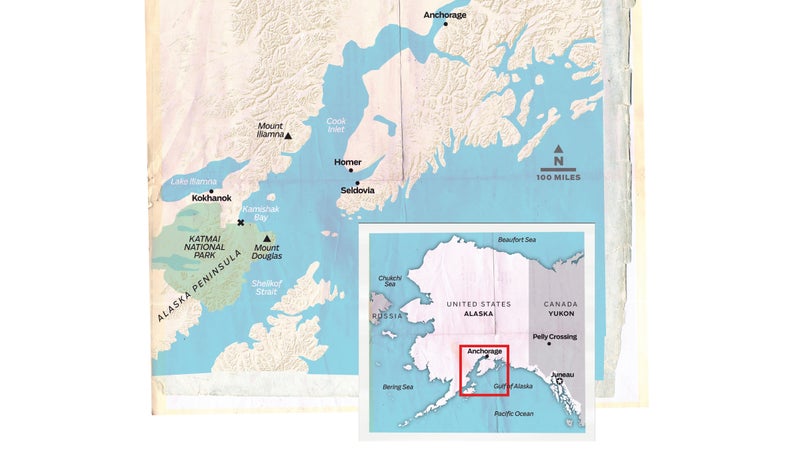
The X marks the spot where Alaskan fisheries biologists encountered François Guenot in May 2014.
(John McCauley)After crossing into the Yukon, François cannibalized several busted bicycles at a dump and pedaled 500 miles north up the Klondike Highway to the town of Pelly Crossing. Situated halfway between Whitehorse and Dawson City, this former outpost of the Hudson Bay Company is now a dreary place with the usual problems faced by First Nations communities: unemployment, alcohol, and drugs. Hand-painted signs on the roadside read: CRACK DOWN ON CRACK DEALERS.
Eddie Tom Tom, a lifelong resident of Pelly Crossing, was shoveling snow one November evening in 2011 when he saw the glow of a headlamp in the distance. The temperature was below zero, and as the man approached, Eddie could see icicles clinging to his blond beard. He had a ragged daypack and a couple of homemade saddlebags strapped to the fender of his junkyard bike. He was looking for a place to string up his tarp—the only shelter he carried.
Eddie invited François to come in and warm up by his woodstove. “He told me his story up to that point,” Eddie recalled, adding that François’s exploits reminded him of tales he’d heard from tribal elders. “We might have done something like that a hundred years ago,” Eddie said. “A lot of us have become too comfortable in our sedentary lifestyles, in our couch culture.” François soon moved into a trailer with a schoolteacher named Gabriel Ellis, and over the next six months he gave the people of Pelly a taste of his relentless optimism.
Eddie’s elderly mother, Rachel, taught François the Athabaskan technique for snaring rabbits and showed him how to cook bannock—a survival staple made with flour, salt, grease, and water. He called her Grand-mother and she made him mittens, mukluks, and a cap trimmed with beaver fur. François taught French cooking at the local community center and later sent Rachel a pair of moccasins he’d sewn himself. “I still use them,” she said.
François's father, Robert Guenot, said without hesitation: “To tell you the truth, we still hope to find him alive. As long as the Coast Guard has not found his corpse, there is a slim chance.”
As much as François thrived among his new friends, his veins pulsed with a potent mix of adrenaline and antifreeze. Over Christmas, Eddie, the tribe’s map guru, helped him plan a 30-mile trek, and the community loaned him a pair of snowshoes, an antler-handled knife, and a $20 bill.
François got lost, though, and spent ten days trying to find his way back. The temperature was below zero as he trudged through snow from 2 p.m. to 10 a.m. to keep warm, sleeping during the day. He survived by rationing a single can of Heinz baked beans that he took from a trapper’s cabin. On his final approach to the town of Mayo, he was crossing the Stewart River when the ice gave way, soaking him in shallow, frigid water. When the local newspaper , he remained effusive and awestruck. “In Europe, you see the print of man everywhere,” he said. “Here, it’s open land. It’s wild.”
Undeterred, François borrowed a pair of skis and set out again, trying to reach a sacred hot spring some 70 miles away. It was April and the thaw was on, so he had to drag his sled and skis behind him. He made it and spent several days lounging in the pools. On his return, he had little choice but to ski along the rotten shore ice of the Pelly River. When the ice turned to open water, he built a raft using a piece of plywood and beams he’d scavenged from an old cabin. He made it back to town after 17 days alone.
Ellis, the schoolteacher, liked François’s company but was furious about his foolhardiness. François, in turn, taunted Ellis, calling him Easy Man because he watched TV and used a sauna. In François’s view, modern society had become lazy, corrupted by convenience foods and fossil fuels. “What appeared to me as reckless was him building up his skills,” Ellis said. When I asked him what motivated François, he said he thought François was probably “trying to outdo his dad.”
François’s friends were still planning to meet up in Russia in September 2012, and he needed to get moving. He raised money chopping wood and bought a secondhand canoe in Whitehorse, outfitted it with a tarp sail, and floated the Yukon River some 850 miles, arriving in Ruby, Alaska, on July 24.��
François had told people that he planned to continue west to the Bering Strait, but he must have thought better of that, because he abruptly made a U-turn. He got a bush-plane ride to Fairbanks, Alaska’s second-largest city, and sold his canoe for a few hundred bucks.��
In early August, he mailed his passport back to France as part of his application for a Russian visa. While he waited, he caught a lift with a trucker heading north; his goal was to cross the Arctic Circle and hike in the Brooks Range. Then he returned to the Yukon River to pick up where he’d left off. It was there that he built his bike trailer, writing FAIRBANKS OR BUST on it with duct tape. When he made it the 60 miles to Fairbanks, he added OR HOMER. Homer was 650 miles south.
On his blog, François wrote about the absurdity of his quest. “What a beautiful bike pack, no?” read a caption beneath a photo of his inelegant rig, backdropped by the regal peaks of the Alaska Range. The plastic wheels of his trash can eroded into lumpy nubs, and he tried to prolong their life with tape. Those repairs lasted about half a mile before the wheels snapped in two. A Good Samaritan—François called him the Trashologist—stuck a proper axle through the trash can’s base and gave him a couple of beefier, rubber-rimmed wheels to keep him going. By the time he reached Homer, on September 12, François had mounted an Alaska license plate alongside a red reflector. He soon learned that his Russian visa application had been denied. He considered building a boat and sailing to Russia illegally, but his friends persuaded him not to. Two weeks later, he borrowed a plastic kayak and paddled across to Seldovia.
Robert, Philippe, and I took a ferry to Seldovia on July 21. It’s a tiny fishing village with roughly 165 residents, and in anticipation of our arrival, some of them had raised a French flag above a wooden boardwalk near the harbor. Otters backstroked in the water and soaked up sun. It was a perfect day.
We got off the ferry with our packs and hoofed it down the Otterbahn Trail through a tunnel of hemlock and spruce. Robert was wearing one of François’s old long-sleeved T-shirts, lime green with the logo of the Buckwheat Ski Classic. When we emerged from the forest onto a beach, Robert picked up a sun-warmed mollusk and slurped its salty juices, as he had once seen his son do on a YouTube video. “Just a taste,” he said.
“It’s not fresh,” Philippe warned. Robert tossed it away and we hiked up to a grassy flat, where we made camp. Philippe donned a black beret, lit a cigarette, and joked that all he needed was a baguette and he’d be a walking cliché.
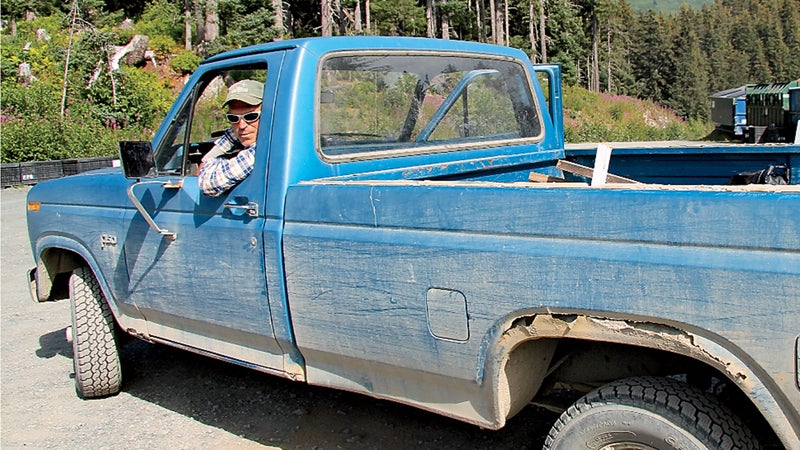
Just as I was zipping my rainfly, an ATV rumbled up and we saw a white-haired man in a baseball cap with the initials F.A.R.T. on the front. “Autre père de François!” he growled, shaking Robert’s hand. This was Kirby Corwin, the self-proclaimed Kayak King of Seldovia, a Long Island, New York, native who runs a guiding outfit called . “François was a nutcase,” Kirby said. “If I wasn’t so friggin’ old, I’d probably do the same thing.”
Kirby told us that Seldovia is a place that takes all comers. A cross-dressing metalhead named Sadi Synn used to strut down the main strip in his pumps and leopard-print miniskirt, and the only people who gave him grief were some pricks in for the weekend from Anchorage. One reason for the town’s anything-goes vibe: it’s cut off from the rest of Alaska by glaciers and can be reached only by boat or plane.
In January 2013, Kirby helped François transform an aluminum skiff into a ramshackle sailboat called The Perl. “It was a piece of shit,” Kirby said. A dusky brown sail hung from the 15-foot mast—a tree trunk that still had bark on it. The flat-bottomed skiff had no keel, so François turned two plywood doors into retractable leeboards, attached to either side of the hull like folded wings. By then, François had attracted a gaggle of young friends who were willing to skinny-dip in winter and join him on hare-brained adventures. They got stranded in The Perl more than a few times and had to paddle back to shore. “Daddy!” François would tell Kirby. “I am a stupid cocksucker.”
Kirby was a good host, taking us kayaking and organizing a cookout. He’d been telling people in town that he was starting a collection to donate to Robert and Philippe for their travel expenses. One night I stopped in at the Linwood Bar and saw him nursing a beer at the counter. “Does François’s family have money?” he said.��
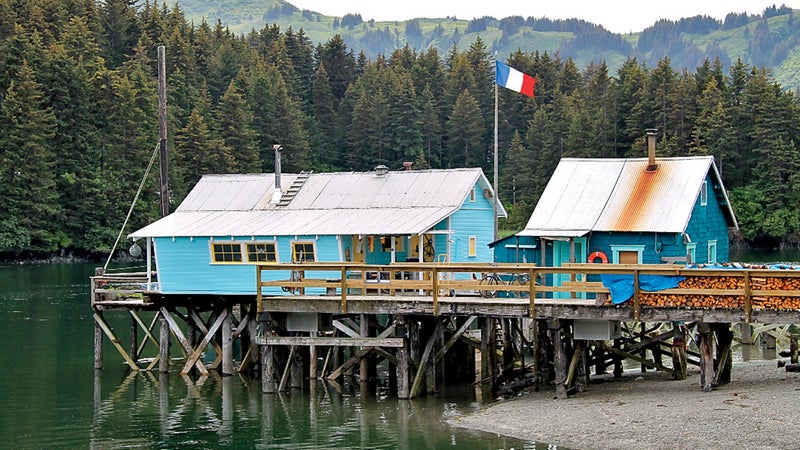
“Robert does have a successful business,” I told him, mentioning an ultralight airplane he owned.
“Aw, shit, he has a plane? We’re not raising money for them! Maybe we can go to France and sponge off them awhile.”
As we met with other people who knew François, I realized that his relationship with the town was a mixed bag. Sure, he was always game to ski off a cliff or huck a backflip, but Seldovians, like many Alaskans, pride themselves on self-reliance, and they work hard to make money and keep up their homesteads. Once locals understood that François wasn’t just passing through but was planning to stay the winter, he became the town’s one-man homeless problem.
Much of François’s daily life in Seldovia was devoted to acquiring the calories he needed to survive. He walked around with a baggie of flour in his pocket and made bannock in borrowed kitchens. He was thrilled when he learned about bidarkies, intertidal mollusks. He’d pry them off rocks with his multitool and eat them raw or roast them over burning logs. Mostly, though, he hunted for dinner invitations.
“François was always hungry. That’s a given. We accepted that,” said a local named Walt Sonen. “He’d hang around, hoping you might have him for dinner. If you had other plans, you’d let him know.”
This tendency to overstay was a recurring theme during François’s travels. “He had a lot of gumption,” said John Miles, an old-timer from Homer who sailed to Russia years ago and once survived wrecking his boat on a rock in the Shelikof Strait. “He kind of took it for granted that, because he’s some kind of adventurer, we should kowtow to him. We don’t live that way. You got to hold your end up. I told him, ‘Time to move on, François.’ ”
One afternoon in Seldovia, Tobben Spurkland, a lanky Norwegian-born engineer with a white Muppet mustache, invited us to his airy two-story home. He and his wife, Tania, an American with a straw-colored bob, laid out a generous spread of yogurt, berries, and smoked salmon. The couple had taken François in when he first arrived, and Tobben laughed about the time François had left his bicycle in the woods during a ten-day pack-rafting expedition. When he returned, a porcupine had gnawed holes in the brown leather seat. François was taking a class in leatherwork and repaired it with dental floss. “He took advantage of every single one of us, and we didn’t mind,” Tobben said. Later, when François asked Tobben to borrow survival gear, including a drysuit, for his planned ocean crossing, it was finally too much. “No,” Tobben told him. “I don’t want to be part of your self-destruction.”
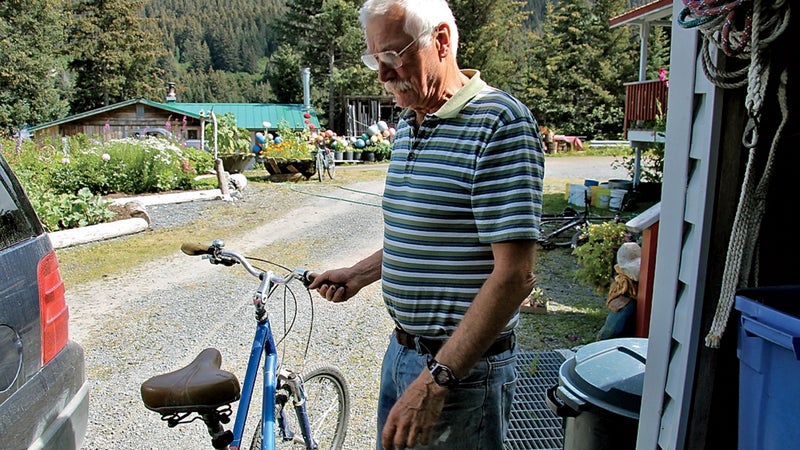
At the end of our visit, Robert asked me to translate a statement he wanted to make. He put his hand on his chest and said, “Du fond de mon coeur, je vous remercie de le prendre comme un fils.”
“From the bottom of my heart,” I said to the Spurklands. “I thank you for taking him in like a son.” Tobben smiled in a taut Nordic way. It occurred to me that he never expected to be repaid for his generosity, in deeds or words. He saw François for what he was: a likable, confused young person unmoored from his homeland. François’s greatest accomplishment, I decided, was his ability to draw out virtue in the people he met, and he in turn was rewarded by this. “Alaska is a vast, emotional land,” he wrote in his journal. “Relationships center me.”
A couple of miles outside town sits the cabin where François spent most of the winter, rent-free. It’s shaded by a dense tree canopy, and it’s positioned on the edge of a deeply eroded creek leading to the shore. As the ground drops away, a gap in the forest gives you a view across Cook Inlet toward the snowy slopes of Mount Iliamna. “This must have been paradise for him,” Robert said when we visited, popping a ripe salmonberry into his mouth.
Inside, we found a few traces of François’s stay, including a pastel-colored map resting above a windowsill. Looking closely, I saw that it was a map of eastern Russia, but the names were in French: Sibérie, Mongolie, and so on. Then I realized—it was his quadrant from the Risk board. “It’s the game,” I told Robert. The game that symbolized all the far-off places François wanted to explore, the journey that he would take to get as far away as possible from his family and, he hoped, the influence of modern life. “You can take it back to France with you,” I said.
Robert passed it wordlessly to Philippe. Philippe ran his hand along the edge and looked over at his father. Then he set it back on the ledge. “No,” he said. “It’s better if it stays here.”
At four o'clock one morning in July 2013, François climbed into his patchwork kayak, shoved off into the Seldovia harbor, and raised his blue sail. Leaving was always hard for him. As he passed the last buoy, he pointed his camera at himself. “Thank you, Seldovia,” he said. “Thank you, everybody, for this winter was amazing. The wind is with me. That’s good.” Halfway across Kachemak Bay, he noticed that his kayak wasn’t tracking. He turned around to see the rudder askew, skimming just under the surface. He muttered something, and the video ends abruptly.
After repairing his craft in Homer, François crossed Cook Inlet during a 17-hour stretch, catching the winds and tides just right. On July 29, at around midnight, a fisherman spotted him ducking into a bay and asked if he needed help. François said he was fine and paddled on. He followed the coastline south and was portaging the 15-mile road to Lake Iliamna when a truck pulled over, and he reluctantly accepted a ride. “I kind of hide, but then they offer me beers,” he said in an e-mail to a friend.
Lake Iliamna is massive, nearly 80 miles wide, shaped like a comet heading west. It’s a place of spooky beauty, one of the only freshwater lakes in the world that has a resident population of seals. Locals say the seals winter in underground caves. Then again, they also believe the lake’s depths harbor a prehistoric monster.��
François bounced between the lakeside and saltwater coasts for a couple of months. He summited an island volcano called Mount Augustine. In September, he met Nicole Evers, a volunteer on the farm of a quirky homestead in Kokhanok, the only town on the lake’s south side. She had just milked one of the goats when she saw him climb down from a yurt loft, wearing moth-eaten long johns.
“He looked like a mess,” she told me. The farm’s owner was the local school principal, Colter Barnes, nicknamed Chewbacca because of his orange lumberjack beard. Colter had invited François to stay with them. “At first we didn’t try to get too close to him,” Nicole recalled. “We thought he was passing by. He kept all his stuff in his backpack, surveying what to do next.”
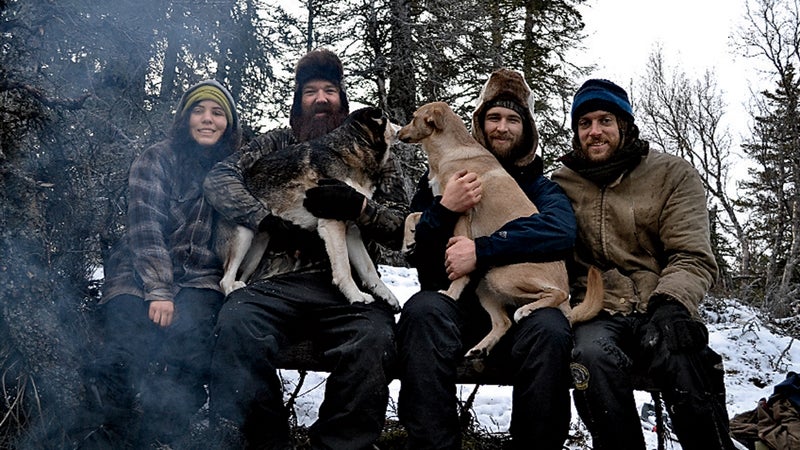
Things started to change when Nicole and her sister, Danielle, joined François on a multi-day trip to a mountain called Seven Sisters. They climbed into the cockpit of his kayak and towed gear behind them in a gray pack raft. One morning they opened the flap of their tent after a storm and all they could see was white. Nicole was from Maine and was tough and smart and independent, traits that François obviously admired in a woman.
Late one night, after a box of red wine, they shared stories about their youth and made love. Nicole was headed to the Peace Corps in Panama and thought François was going to pack up and leave any day.��
“It doesn’t mean anything,” he told her.
“I don’t have boyfriends,” she told him.
He cooked her pancakes and cut them in the shape of a heart. He helped on the farm by building a rabbit hutch, tarring a roof, slaughtering pigs. Colter and Nicole appreciated his help, but he was so relentlessly stubborn. “I do not like the petrol,” he would tell them, refusing to ride an ATV. He believed their animals should be free-range. One day, Nicole found him standing outside the chicken coop, distraught. “Mais non! Mais non!” he repeated. He’d left the door open, and a dog had massacred their hens.
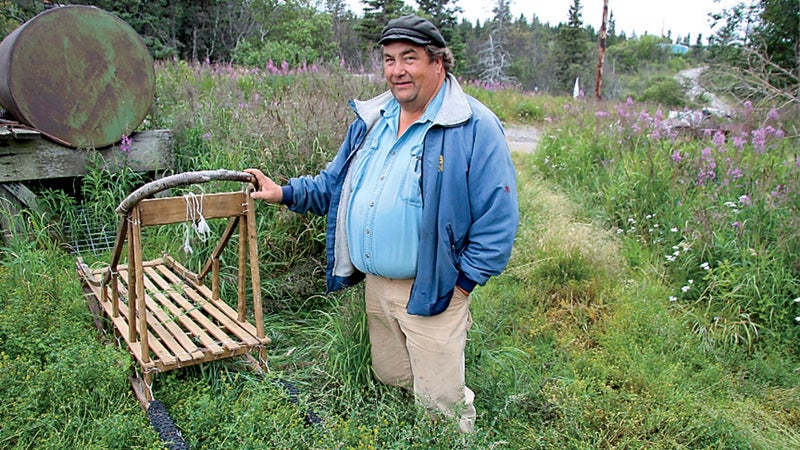
Over Christmas, it dawned on François that Nicole had also been hooking up with Colter, and he was floored. “We were trying to all be friends on this hippie commune, free love and all that,” Nicole said. “He gave off this vibe that he was like that, but deep down he was a very sensitive, intimate little boy.” François took a breath and went downstairs to the workshop. Nicole heard the muffled roar of him cursing. “Putain!” he shouted.
Colter tried to reason with François, explaining that they were all just having fun before going their separate ways in the spring, but François was not appeased. “I’m not like you Americans,” he said. In late January, he wrote Nicole an expletive-laced letter that he never sent and stormed out.
During his exile, François dedicated himself to betterment, spending time with Gary Nielsen, a portly, bassoon-voiced man who ran the local general store. “He was under a tree about a quarter-mile away,” Nielsen told me while he sat on the couch in his living room. “He moved up here and was staying in my steam bath.”
François had been feeding Nielsen’s sled dogs over the winter and keeping them in shape on a sled he built himself. Then, as the ice broke up in early spring, he set out on a journey. He loaded a small backpack and walked west along the shore of Lake Iliamna. Locals had stopped walking on the ice a week or two earlier, and they warned him to stay off. After 20 miles, he turned north and crossed the lake at the mouth of a river, where the ice is thinnest. When he made it to the other shore, it seemed like a miracle.
François merrily kept going, visiting settlements en route. By the time he meandered back to Kokhanok, 45 days later, he felt rejuvenated. “I made some friends along my walk and connected with the spirits of the places I visited,” he wrote. “The villagers of the lake always welcomed me, gave me food, sometimes they accepted my help, and I discovered their way of life.”
Before sunrise one day in early August, Philippe got a call from an unknown number, but there was only silence on the other end. He was certain it had to be François, but when he called back the number was disconnected.
By this time, I’d already headed off on my own to continue reporting. Meanwhile, Robert and Philippe met a French-speaking woman who was convinced that the search for François was inadequate, and she helped them set up a meeting with Alaska state troopers to try to initiate a new hunt on land. Robert and Philippe made an appeal for help in the Dispatch, but Alaska had moved on. On August 17, they returned to France.
Three weeks later, Andy Schroeder, the executive director of the , was motoring alone in a 13-foot Zodiac, scouting sites for a marine-debris cleanup his organization runs every year. As he pulled up to the beach on a small island north of Kodiak, he saw what looked like a body sprawled in the shallow water. It was little more than a skeleton, kept intact by neoprene chest waders and a green rain jacket. It was so badly decomposed that Schroeder couldn’t tell if it was a man or a woman. Following instructions he got on his cell phone from state troopers, he wrapped it in a tarp and dragged it above the tide line.��
Dental records confirmed that it was François. In January of this year, his remains were cremated and shipped back to Maîche, where a ceremony was held at a small church. “As parents, we should not regret having accomplished our mission of raising our children to be men who are free, independent, and autonomous,” Robert said at the funeral. “We have a life to cross. Some cross it faster than others.”
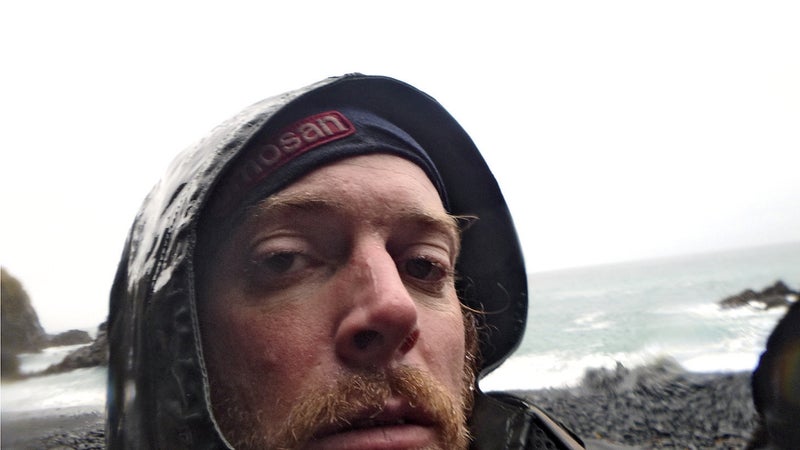
Almost everything we know about François’s final days comes from the journals found in his drybag on the beach. He departed Kokhanok on May 22, 2014, an overstuffed pack on his back, junk dangling off like Christmas ornaments. He had a small collection of paperback books, including Never Cry Wolf by Canadian environmentalist Farley Mowat and an anthology of Victor Hugo stories. Before François left, he wrote a poem in English for Nielsen about his longing to be at sea. “Each wave is a pocket of my soul. Make my life real as it does!” He signed it “the crazy Frenchman.”
On his first night, François camped near Gibraltar Lake and then fought his way to the coast through alder, rocky canyons, and beaver ponds. “Voila, the first day of my adventure to the Ocean,” he wrote in his journal. A local bush pilot had dropped his kayak and provisions at a ramshackle coastal cabin.��
After spending a few days there he kayaked north, camping and fishing in Bruin Bay, before turning south again in early June. He was heading down to Chignik or maybe planning to trek across the Alaska Peninsula to Egegik. The only thing he knew for sure was that he was headed to see the “famille �ҳܱ�Դdz�.”
Flipping through the journal in Seldovia, Robert had been captivated by all these details. I asked him then if he was starting to understand his son. “He discovered a true way to live,” he told me. “This trip has given me a lot of time to reflect.”
“Do you think you’re going to change things in your life?” I asked.
“I am going to attach less importance to the material world.”
Robert turned the page. In early June, the journal said, the weather on the water proved unpredictable. François hoped to paddle 12 miles a day, but he was fighting the wind and traveling less than half that. “I have made very little progress,” he despaired upon arriving at the north side of Cape Douglas on June 14. He stashed his gear underneath a cliff and tried fishing. “There is a lot of wind this evening,” he wrote. “The Pacific ocean comforts me. The long and high waves make me imagine far away places.”
He knew the only way he was going to meet his father in time was to paddle away from the coast, where he could chance it on the swift and unpredictable currents of the Shelikof Strait. At 1 P.M. on June 15, he wrote his last entry before rounding the cape and pointing himself toward open water. The skies were clear and the water quiet, but he knew what he was getting into.
“Shit, I am a fool,” he scribbled. “Completely crazy. I’ll go on. We shall see.”
Brendan Borrell () writes for Scientific American and Smithsonian. He lives in Brooklyn, New York.
